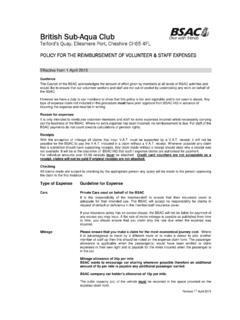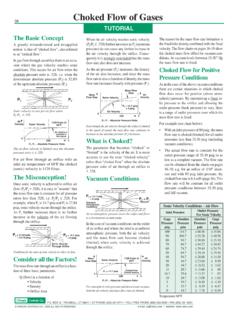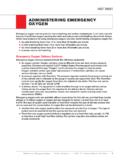Transcription of MEDICAL MALPRACTICE STANDARDS OF CARE / …
1 MEDICAL MALPRACTICE STANDARDS OF care / DEVIATIONSHOSPITAL STANDARDS OF care care THAT WAS GIVENDEVIATIONASSESSMENT:1. Assess fetus in distress via continuous electronic fetalmonitoring (EFM). Evaluate FMR tracing noting:Unable to hear Fetal Heart Tones(FHT s) on initial ER assessment. Nofetal monitor was used. * a. uterine activity:Uterine activity not checked or at leastnot documented. * 1) tachysystole - hyperstimulation (>5 UC s in 10minutes or closer that q 2 minutes) 2) polysystole - coupling, ineffective labor pattern3) hypertonia - palpate for uterine relaxationfollowing contraction 4) absence of uterine tone - uterine rupture5) tetanic contractions > 90 seconds long or > 70mmHg in strength (IVPC) b. Baseline FHR:Fetal bradycardia present with FHR * 1) reassuring stable rate between 110-160 BPM20-50 BPM during entire period prior 2) fetal tachycardia > 160 sustained > 10 minsto delivery (1230 until delivery at1356).
2 3) fetal bradycardia < 110 c. FHR variability both long and short term:This was not done as EFM was not * 1) reassuring short term ) decreased or absent variability 3) exaggerated or salutatory variability 4) true sinusoidal pattern 5) response to fetal scalp stimulation d. periodic changes:Fetal monitor was not used and no * 1) accelerationssigns of active labor were charted. 2) early decelerations 3) late decelerations of any magnitude 4) variable decelerations 5) prolonged decelerations2. Determine factors related to progression and stage oflabor. a. strength of uterine contractions and resting toneContractions were not checked. *b. vaginal exam - dilation, effacement, presentation,position, stationVaginal exam was not performed or atleast not documented.
3 *c. dystocia, malpresentation, rapid descent of head, imminent delivery, cord prolapseNot documented. *3. Assess:a. Maternal vital signs, noting hypotension,hypertension, elevated temperatureVital signs charted. Hypotensiondocumented but no treatment wasgiven. *b. vaginal discharge: meconium, increased bleeding, intact as per Labor recent medication which may affect fetus, ,narcotics, phenergan, terbutaline, MgSo4,No medications were MALPRACTICE STANDARDS OF care / DEVIATIONS butaphanol, lebatalold. last epidural dose, noting vasodilation andhypotensionN/A e. maternal position - supine- vena caval syndromePt was supine (lying on back) untiltransfer to Labor Room at 1320 whenshe was turned to her left side. *4. Review current labor status, OB, and MEDICAL history forrisk documented regarding riskfactors.
4 *INTERVENTIONS:5. Select interventions to treat underlying treatment was given forhypotension. * NOTE: It is not necessary to proceed with subsequentsteps if current intervention corrects a non-reassuring Change maternal position: laterally, then to all fours orknee position was not changeduntil 1320 when she was placed on herleft side. *7. Correct maternal hypotension: move patient out ofsupine position, check blood pressure, increase IV rate,elevate legs if not contraindicated. NOTE: For severe hypotension related to epidural, Anesthesiologist may give ephedrine hypotension occurred, IV wasnot in and patients position wasunchanged until time of transfer toLabor Room. *8. Discontinue oxytocin if Administer oxygen at 8-10 LPM via non-rebreather at 5 liters per nasal cannula firstdocumented at 1320 in Labor Roomrecords.
5 This was ordered in the ER at1245. *10. Perform vaginal exam to assess:a. rapid descent of head/imminent deliveryb. prolapse of cordc. accelerations due to scalp stimulationNo vaginal exam was everdocumented. * NOTE: Elevate presenting part if creating pressure on Notify physician of fetal heart rate, variability, MD notified of inability to hearFHT s on original ER MD was not informed until 25minutes after initial finding of lowFHT s. *12. Maintain patient on bedrest until further orders was on bedrest until after the babywas MALPRACTICE STANDARDS OF care / DEVIATIONS13. Maintain continuous electronic fetal monitoring with alegible tracing. If unable to record a continuous tracing,or when variability is in question, apply fetal scalpelectrode per continuous fetal monitoring wasperformed.
6 No fetal scalp electrodewas ever attempted. *14. Do not reactivate epidural until fetal distress is Administer tocolytic as ordered for hypertonus,tachysystole, or tetanic Assist physician with fetal scalp sampling if Initiate amnioinfusion to relieve umbilical Prepare for began in labor room afterOB was Notify NICU that resuscitation may be required at were present at delivery20. Send blood specimen to lab on labs Ascertain whether placenta should be sent to was sent for Reassure patient and support in Intraoperative :23. Explain possible causes of fetal distress and expected planof documented. *DOCUMENTATION:24. Document on designated forms: a. assessmentAssessment was documented by ERRN. b. interventions and responseInterventions were documented by ERRN in progress notes and in Laborroom record progress notes.
7 C. education and responseNot :N/A - Does not apply* - deviation from policy





